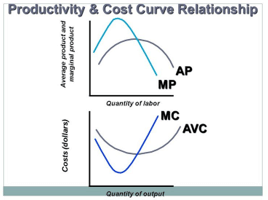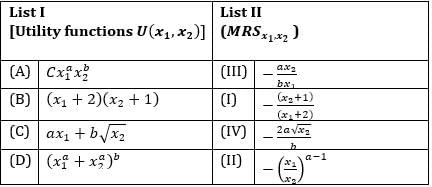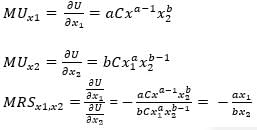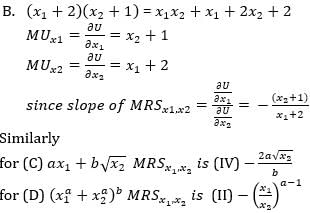CUET PG Exam > CUET PG Tests > CUET PG Economics Mock Test- 6 - CUET PG MCQ
CUET PG Economics Mock Test- 6 - CUET PG MCQ
Test Description
30 Questions MCQ Test - CUET PG Economics Mock Test- 6
CUET PG Economics Mock Test- 6 for CUET PG 2025 is part of CUET PG preparation. The CUET PG Economics Mock Test- 6 questions and answers have been prepared
according to the CUET PG exam syllabus.The CUET PG Economics Mock Test- 6 MCQs are made for CUET PG 2025 Exam.
Find important definitions, questions, notes, meanings, examples, exercises, MCQs and online tests for CUET PG Economics Mock Test- 6 below.
Solutions of CUET PG Economics Mock Test- 6 questions in English are available as part of our course for CUET PG & CUET PG Economics Mock Test- 6 solutions in
Hindi for CUET PG course.
Download more important topics, notes, lectures and mock test series for CUET PG Exam by signing up for free. Attempt CUET PG Economics Mock Test- 6 | 75 questions in 90 minutes | Mock test for CUET PG preparation | Free important questions MCQ to study for CUET PG Exam | Download free PDF with solutions
CUET PG Economics Mock Test- 6 - Question 1
What is RBI’s target of inflation for the period 2021-26?
Detailed Solution for CUET PG Economics Mock Test- 6 - Question 1
CUET PG Economics Mock Test- 6 - Question 2
Given below are two statements:
Statement I: Coefficient of correlation can not be less than – 1.
Statement II: Regression coefficient can not be less than – 1.
In the light of the above statements, choose the correct answer from the options given below:
Statement I: Coefficient of correlation can not be less than – 1.
Statement II: Regression coefficient can not be less than – 1.
In the light of the above statements, choose the correct answer from the options given below:
Detailed Solution for CUET PG Economics Mock Test- 6 - Question 2
CUET PG Economics Mock Test- 6 - Question 3
What is the number of degrees of freedom of the residual sum of squares in a simple bivariate linear regression with 100 observations?
Detailed Solution for CUET PG Economics Mock Test- 6 - Question 3
CUET PG Economics Mock Test- 6 - Question 4
Which one of the following renowned economists was a member of the Royal Commission on Currency and Finance of 1913?
Detailed Solution for CUET PG Economics Mock Test- 6 - Question 4
CUET PG Economics Mock Test- 6 - Question 5
Match List I with List II
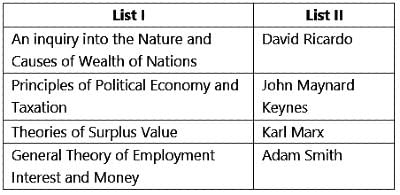
Choose the correct answer from the options given below:

Choose the correct answer from the options given below:
Detailed Solution for CUET PG Economics Mock Test- 6 - Question 5
Detailed Solution for CUET PG Economics Mock Test- 6 - Question 6
CUET PG Economics Mock Test- 6 - Question 7
Suppose the correlation coefficient between two variables X and Y is 0.6, what proportion of variation in Y is explained by variation in X?
Detailed Solution for CUET PG Economics Mock Test- 6 - Question 7
CUET PG Economics Mock Test- 6 - Question 8
What is the degree homogeneity of f(x, y) = x³ / y + y³ / x
Detailed Solution for CUET PG Economics Mock Test- 6 - Question 8
CUET PG Economics Mock Test- 6 - Question 9
Given below are two statements: one is labelled as Assertion A and the other is labelled as Reason R.
- Assertion (A):According to the Heckscher-Ohlin model, free trade results in equalisation of factor prices across nations.
- Reason (R): This is because the model assumes perfect international mobility of the factors of production.
In the light of the above statements, choose the correct answer from the options given below:
Detailed Solution for CUET PG Economics Mock Test- 6 - Question 9
CUET PG Economics Mock Test- 6 - Question 10
Suppose massive capital outflows cause nominal exchange rate to depreciate by 10%. At the same time, foreign and domestic price levels rise by 5% and 20% respectively. What will be the approximate change in real exchange rate?
Detailed Solution for CUET PG Economics Mock Test- 6 - Question 10
CUET PG Economics Mock Test- 6 - Question 11
Arrange the following in correct chronological order starting with the earliest:
A. 1st meeting of Monetary Policy committee
B. Export Import Bank of India commenced operations
C. Enactment of FEMA
D. Digital India campaign
E. Narasimhan Committee-II
Choose the correct answer from the options given below:
A. 1st meeting of Monetary Policy committee
B. Export Import Bank of India commenced operations
C. Enactment of FEMA
D. Digital India campaign
E. Narasimhan Committee-II
Choose the correct answer from the options given below:
Detailed Solution for CUET PG Economics Mock Test- 6 - Question 11
CUET PG Economics Mock Test- 6 - Question 12
The rate of growth of the output of an economy during a period is 5% If the shares of capital and labour are 0.6 and 0.4 respectively and capital and labour grow at 10% and 5% respectively, what is the solow residual for the output function given as y = A · kα L(1-α)
Detailed Solution for CUET PG Economics Mock Test- 6 - Question 12
CUET PG Economics Mock Test- 6 - Question 13
Match List I with List II

Choose the correct answer from the options given below:

Choose the correct answer from the options given below:
Detailed Solution for CUET PG Economics Mock Test- 6 - Question 13
CUET PG Economics Mock Test- 6 - Question 14
Given below are two statements:
- Statement I: When the economy is in liquidity trap, the LM curve is vertical.
- Statement II: Monetary policy is ineffective when the economy is in liquidity trap.
In the light of the above statements, choose the correct answer from the options given below:
Detailed Solution for CUET PG Economics Mock Test- 6 - Question 14
CUET PG Economics Mock Test- 6 - Question 15
Given below are two statements:
Statement-I: In the short-run, the rising part of the marginal cost curve is due to diminishing marginal product.
Statement-II: In the short-run. The falling part of the marginal cost curve implies existence of diminishing marginal product.
In the light of the above statements, choose the correct answer from the options given below:
Statement-I: In the short-run, the rising part of the marginal cost curve is due to diminishing marginal product.
Statement-II: In the short-run. The falling part of the marginal cost curve implies existence of diminishing marginal product.
In the light of the above statements, choose the correct answer from the options given below:
Detailed Solution for CUET PG Economics Mock Test- 6 - Question 15
Detailed Solution for CUET PG Economics Mock Test- 6 - Question 16
Detailed Solution for CUET PG Economics Mock Test- 6 - Question 17
CUET PG Economics Mock Test- 6 - Question 18
What are the values of x that satisfy the equation x2 + 4x + 3 = 0
Detailed Solution for CUET PG Economics Mock Test- 6 - Question 18
CUET PG Economics Mock Test- 6 - Question 19
Suppose in an economy, Y = C + I, C = 500 + 0. 8Y, I = 1000, supply of money (MS) = 1000, transaction demand for money (MDT) = 0. 1Y, speculative demand for money (MDS)= 1000 - 75r, where r is the percentage rate of interest. What is the equilibrium value of r in the economy?
Detailed Solution for CUET PG Economics Mock Test- 6 - Question 19
CUET PG Economics Mock Test- 6 - Question 20
The first attempt to initiate economic planning in India was made by:
Detailed Solution for CUET PG Economics Mock Test- 6 - Question 20
CUET PG Economics Mock Test- 6 - Question 21
Consider the following centrally schemes in India and the right sequence of time (year) when they were launched, from earliest to latest.
(A) Right to Education
(B) Ujjwala
(C) Swachh Bharat Abhiyan
(D) Beti Bachao Beti Padhao
Choose the correct answer from the options given below:
(A) Right to Education
(B) Ujjwala
(C) Swachh Bharat Abhiyan
(D) Beti Bachao Beti Padhao
Choose the correct answer from the options given below:
Detailed Solution for CUET PG Economics Mock Test- 6 - Question 21
CUET PG Economics Mock Test- 6 - Question 22
In the WTO’s agreement on agriculture, ‘blue box’ subsidies refer to
Detailed Solution for CUET PG Economics Mock Test- 6 - Question 22
CUET PG Economics Mock Test- 6 - Question 23
Match List – with List – II:
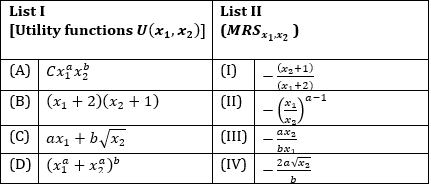
Choose the correct answer from the options given below:
Detailed Solution for CUET PG Economics Mock Test- 6 - Question 23
CUET PG Economics Mock Test- 6 - Question 24
The money multiplier in an economy increases with ____.
Detailed Solution for CUET PG Economics Mock Test- 6 - Question 24
Detailed Solution for CUET PG Economics Mock Test- 6 - Question 25
CUET PG Economics Mock Test- 6 - Question 26
Lilly and Kylie are stranded together on a desert island. In a single day Kylie can make either 2 straw shelters or catch 10 fish. Lily can make 4 straw shelters or catch 8 fish in a day. Which of the following is the correct reason that Kylie should specialize in producing fish?
Detailed Solution for CUET PG Economics Mock Test- 6 - Question 26
CUET PG Economics Mock Test- 6 - Question 27
Which of the following is not a part of India’s national debt?
Detailed Solution for CUET PG Economics Mock Test- 6 - Question 27
Detailed Solution for CUET PG Economics Mock Test- 6 - Question 28
CUET PG Economics Mock Test- 6 - Question 29
Given below are two statements:
Statement I: The main features of the Industrial Policy - 1991 includes abolition of industrial licensing, diminishing role of public sectors, MRTP limit scraped. conditions on entry of foreign investment and technology liberalized and so on.
Statement II: First Industrial Policy Resolution was issued in 1951. In the light of the above statements, choose the most appropriate answer from the options given below:
Statement I: The main features of the Industrial Policy - 1991 includes abolition of industrial licensing, diminishing role of public sectors, MRTP limit scraped. conditions on entry of foreign investment and technology liberalized and so on.
Statement II: First Industrial Policy Resolution was issued in 1951. In the light of the above statements, choose the most appropriate answer from the options given below:
Detailed Solution for CUET PG Economics Mock Test- 6 - Question 29
CUET PG Economics Mock Test- 6 - Question 30
In a frequency distribution, the last cumulative frequency is 500. Q3 (Third Quartile) must lie in
Detailed Solution for CUET PG Economics Mock Test- 6 - Question 30
View more questions
Information about CUET PG Economics Mock Test- 6 Page
In this test you can find the Exam questions for CUET PG Economics Mock Test- 6 solved & explained in the simplest way possible.
Besides giving Questions and answers for CUET PG Economics Mock Test- 6, EduRev gives you an ample number of Online tests for practice
Download as PDF




